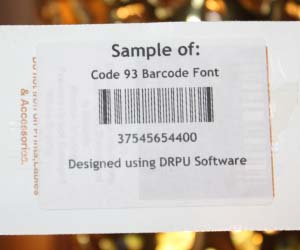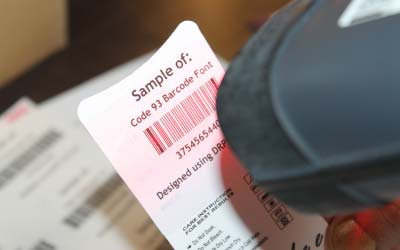Scanning of Code-93 Barcode
Scanning a Code 93 barcode is a simple process that can be accomplished using a barcode scanner or a mobile device with a built-in camera. In this section, we will discuss the steps for scanning a Code 93 barcode using both methods.
Method 1: Barcode Scanner
-
➤
Step 1:
Turn on your barcode scanner and ensure it is properly connected to your device (if applicable).
-
➤
Step 2:
Aim the scanner at the Code 93 barcode you want to scan, ensuring that the barcode is within the scanner's field of view.
-
➤
Step 3:
Press the trigger button (if applicable) or wait for the scanner to automatically detect the barcode.
-
➤
Step 4:
Wait for the scanner to read the barcode, which is typically indicated by a beep or LED light.
-
➤
Step 5:
If necessary, transfer the scanned data to your device or computer.
Method 2: Mobile Device with Camera
-
❉
Step 1:
Open your device's barcode scanning app or download a barcode scanner app from your device's app store.
-
❉
Step 2:
Aim your device's camera at the Code 93 barcode you want to scan, ensuring that the barcode is in focus and within the app's scanning area.
-
❉
Step 3:
Wait for the app to detect the barcode and automatically capture the image.
-
❉
Step 4:
Wait for the app to read the barcode and display the scanned data.
-
❉
Step 5:
If necessary, transfer the scanned data to another app or program on your device.
In general, scanning a Code 93 barcode is a simple and straightforward process that can be accomplished using either a barcode scanner or a mobile device with a camera. Whether you are using a scanner or a mobile device, it is important to ensure that the barcode is properly aligned and within the scanner's field of view in order to ensure accurate scanning results. By following the steps outlined above, you can easily scan Code 93 barcodes for your business or personal use.
Reading of CODE-93 Barcode with Different Devices
-
Barcode Scanners:
Barcode scanners are devices that use a laser or LED light to scan barcodes. They can read both linear and 2D barcodes, including Code 93. Barcode scanners are commonly used in retail stores, warehouses, and distribution centers to scan barcodes on products and packages.
-
POS Systems:
Point-of-sale (POS) systems used in retail stores and restaurants often have built-in barcode scanners that can read Code 93 barcodes. These systems use a laser or LED light to scan the barcode and then automatically retrieve the product information from the database.
-
RFID Scanners:
Radio-frequency identification (RFID) scanners are used to read RFID tags that are attached to products or packages. Some RFID scanners also have the ability to read linear barcodes, including Code 93. These scanners use radio waves to read the information encoded in the barcode.
-
Mobile Devices
Mobile devices such as smartphones and tablets can also read Code 93 barcodes using a barcode scanning app. These apps use the device's camera to capture the barcode image and then decode it to reveal the encoded data. Many barcode scanning apps are available for free or for a small fee in the app stores of iOS and Android devices.
-
Computer Scanners:
Computer scanners are devices that are connected to a computer and are used to scan documents and images. Many computer scanners also have the capability to scan barcodes, including Code 93. To scan a barcode with a computer scanner, the user must open a scanning software that has the ability to decode barcodes.
-
Industrial Scanners:
Industrial scanners are designed to withstand harsh environments such as warehouses and distribution centres. These scanners can read both linear and 2D barcodes, including Code 93. Industrial scanners are typically more expensive than handheld barcode scanners but are more durable and have a longer lifespan.
International Usage of Code-93 Barcode
Code 93 is a widely used barcode symbology that can encode a wide range of characters, including uppercase letters, numbers, and a variety of special characters. The barcode can be used in a variety of applications and industries, from retail to logistics to healthcare. In this section, we will discuss the international applications of Code 93 barcode.

-
Code 93 is a Global Standard:
Which means that it can be used in any country around the world. The barcode can be read by a variety of devices, including barcode scanners and mobile devices, which makes it easy to use in a variety of settings. In addition, many countries have their own unique barcode standards, but Code 93 is one of the few barcode symbologies that is recognized and accepted internationally.
-
Healthcare Industry:
Code 93 is often used to track patient information and medical records. The barcode can be used to encode a patient's name, date of birth, medical history, and other important information, which can be easily accessed by healthcare professionals using a barcode scanner. This makes it easier for healthcare professionals to track patient information and provide better care.
-
Logistics and Shipping Industries
Code 93 is often used to track packages and shipments. The barcode can be used to encode the destination address, shipping information, and other important details about the package. This information can be easily accessed by shipping companies using a barcode scanner, which makes it easier to track packages and ensure they are delivered to the correct destination.
-
Retail Industry:
Code 93 is often used to track inventory and manage stock levels. The barcode can be used to encode information about the product, such as the product name, SKU number, and price. This information can be easily accessed by retail staff using a barcode scanner, which makes it easier to manage inventory and ensure that products are restocked in a timely manner.
Advantage:
Code 93 is its ability to encode a large number of characters in a relatively small space. This makes it an ideal barcode symbology for applications that require a lot of information to be encoded in a small space, such as inventory tracking, asset management, and product identification. Code 93 can also be easily read by a variety of barcode scanners, which makes it an ideal choice for businesses and organizations that need to scan barcodes quickly and accurately.
Cost Implementation of Code-93 Barcode
The cost of implementing Code 93 barcode will depend on several factors, including the size and scope of the project, the equipment and software required, and any additional costs such as training and maintenance. In this section, we will discuss the various costs associated with implementing Code 93 barcode.
-
Barcode Scanner:
The first cost associated with implementing Code 93 barcode is the barcode scanner. Barcode scanners can range in price from a few hundred dollars to several thousand dollars depending on the features and capabilities of the scanner. A basic handheld scanner may cost around $200, while a more advanced scanner with additional features such as Bluetooth connectivity and image capture capabilities can cost upwards of $2,000.
-
Barcode Printer:
In addition to a barcode scanner, you will also need a barcode printer to create and print the Code 93 barcodes. Barcode printers can range in price from a few hundred dollars to several thousand dollars depending on the features and capabilities of the printer. A basic desktop barcode printer may cost around $300, while a more advanced industrial printer with high-speed printing capabilities and a larger print volume can cost upwards of $5,000.
-
Barcode Labels:
Barcode labels are another cost associated with implementing Code 93 barcode. The cost of barcode labels will depend on the size and quantity of labels required. A roll of 1,000 barcode labels may cost around $20, while a roll of 10,000 labels may cost upwards of $100.
-
Software:
You will also need software to create and print the Code 93 barcodes. The cost of software will depend on the type of software required and the features and capabilities of the software. Basic barcode software may cost around $100, while more advanced software with additional features such as inventory management and asset tracking can cost upwards of $1,000.
-
Training:
Depending on the size and complexity of the project, you may also need to provide training to employees on how to use the barcode scanners and software. The cost of training will depend on the number of employees and the duration of the training. Basic training may cost a few hundred dollars, while more extensive training may cost several thousand dollars.
-
Maintenance:
Finally, you will need to budget for ongoing maintenance and support for the barcode system. This may include software updates, equipment repairs, and general technical support. The cost of maintenance and support will depend on the size and complexity of the system and the level of support required.
In conclusion, the cost of implementing Code 93 barcode will depend on several factors, including the size and scope of the project, the equipment and software required, and any additional costs such as training and maintenance. While there are certainly costs associated with implementing a barcode system, the benefits of increased efficiency and accuracy in data tracking and management can ultimately save businesses time and money in the long run.
